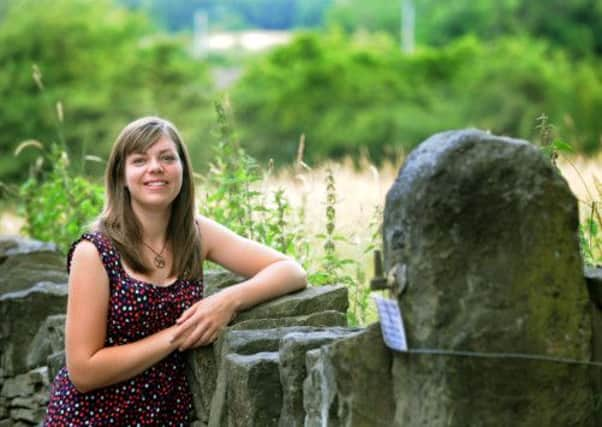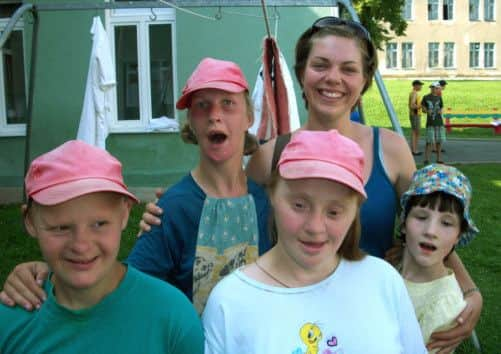Smiles of orphans left to live with the fallout


Claire Drake wasn’t even a year old when the catastrophic Chernobyl nuclear accident occurred on April 26, 1986. But she was so moved after visiting the area with her mother when she was 14 she has since returned several times as a volunteer, paying her own way and staying in basic accommodation to help the victims.
“My family used to host children from Belarus for a recuperative holiday for a month in the summer in the UK through the Chernobyl Children’s Lifeline,” explains Claire. “Between 1998 and 2000 we hosted nine girls who were a similar age to me at the time. The first girl who visited was Alesia, three days older than me, in 1998. When I was 14 in 2000 we visited Alesia and her family in Belarus.
Advertisement
Hide AdAdvertisement
Hide Ad“We were there for a week. It changed my whole world perspective; there were people farming land in old traditional ways, drinking milk straight from the cow, babushkas dressed in traditional clothing. It was an eye-opener.”


It can be a culture shock for children who visit the UK, but they have an interpreter and a good support network. “I do get asked if I think it is cruel for them to come here and see a good life, then to go back to Belarus, but they actually look forward to going home with new aspirations, and want more out of life.”
Last year Claire and her boyfriend Colin visited Alesia again. Now married, Alesia has been able to go to university and has a successful career working for a telephone company.
Claire has visited Goradiche in the west of Belarus three times to support the children, who have grown up with various health issues, including epilepsy, cystic fibrosis and Down’s syndrome, some of which are a result of the Chernobyl disaster, others a result of alcoholism or families living in poverty.
Advertisement
Hide AdAdvertisement
Hide AdClaire and Colin volunteer with the Burren Chernobyl Project, which was established in 1993 to help with the child and adult victims of the fallout from the Chernobyl reactor explosion. Many projects have been carried out to assist the children and their families who are enduring the effects of exposure to radiation and the other social and economic problems facing them.
“When Chernobyl happened, the wind was blowing north which is why so many people were affected in Belarus. It is still a very poor country and has struggled to develop economically since the Chernobyl disaster and leaving the Soviet Union.
“In Belarus, they call it an ‘insitution’, as opposed to an orphanage. They are like the places we had here before the war, and in wartime. The ill and disabled are sent to this ‘other place’,” explained Claire. “The place we visit is specifically for disabled children who are there for numerous reasons. They don’t have the health and social care system we have here for parents to look after them, so they have to ‘give up’ their children.
“The children come here when they are four years old, after leaving another institution for babies. When they are 18, they can stay and help out – the girls with the laundry and in the kitchen, the boys outside farming.
Advertisement
Hide AdAdvertisement
Hide Ad“Some go on to adult institutions but I have never visited – I don’t think I’d be able to cope. They’re like prisons.”
The centre is clean and modern, but has steps everywhere, which means many of the children who live there stay indoors all year round, except when volunteers like Claire and Colin visit. There are two members of staff to 15-20 children in a group, so they only have time to deal with basic needs. There is no entertainment, no trips out.
“Volunteers tend to visit in holiday times, generally in the summer. So winter must be dire for them, it’s so cold.”
They travel to Goradiche, a three-hour drive from the airport in Minsk, and stay for two weeks.
Advertisement
Hide AdAdvertisement
Hide Ad“When we are there we visit the children and interact with them as best we can based on their disabilities. Our suitcases are mainly full of things for the children with just the basics for ourselves.
“Some are bed-bound so we take them for walks in wheelchairs, a rare opportunity to get outside for fresh air. For others we have craft materials so make simple things like bracelets, collages or do colouring.
“The girls always enjoy the bits of make-up, jewellery and hair accessories we bring and the boys love an evening game of football. When we arrive their faces just break out in smiles. We never see them sad. We have to focus on their faces and on them as people, and try to make their lives just a little bit better while we are there.
“It is heartbreaking, but you have to put it aside when you’re there, otherwise you’re no use to them. Sometimes you have to find somewhere to have a private weep.”
Advertisement
Hide AdAdvertisement
Hide AdClaire makes jams and chutneys from fruit and vegetables on her allotment near her home in Wyke, to raise money for much needed resources for the children.
While in Minsk, Claire buys charms, keyrings, and matryoshkas – stacking dolls – which she then sells at a small profit at craft fairs in Leeds and Bradford. All funds are used to buy nappies, clothes, school equipment and craft materials.
“We also are able to use money to hire a bus for some of the children to have a trip outside the orphanage; they rarely get outside the grounds so it’s a rare treat they look forward to.”
Claire and Colin also work together for environmental charity Bradford Community Environment Project (BCEP).
Advertisement
Hide AdAdvertisement
Hide Ad“Our work helps us when we are in the orphanage as we both work with children so have experience for when we are there.”
Chernobyl’s deadly legacy
On April 26, 1986 Chernobyl’s reactor four suffered a catastrophic power increase, leading to explosions in its core. This dispersed large quantities of radioactive fuel and core materials into the atmosphere.
Four hundred times more radioactive material was released than had been by the atomic bombing of Hiroshima.
Among the residents of Belarus, the Russian Federation and Ukraine, there had been up to the year 2005 more than 6,000 cases of thyroid cancer reported in children and adolescents who were exposed at the time of the accident, and more cases can be expected during the next decades.
Advertisement
Hide AdAdvertisement
Hide AdClaire and Colin will be travelling to the orphanage on August 9. If you would like to help by making a donation visit www.facebook.com/pages/Crafts-for-Belarus/ 220139704716070
or email [email protected].
To donate to Burren Chernobyl Project visit www.mycharity.ie/event/bcp_orphanage_trip/.